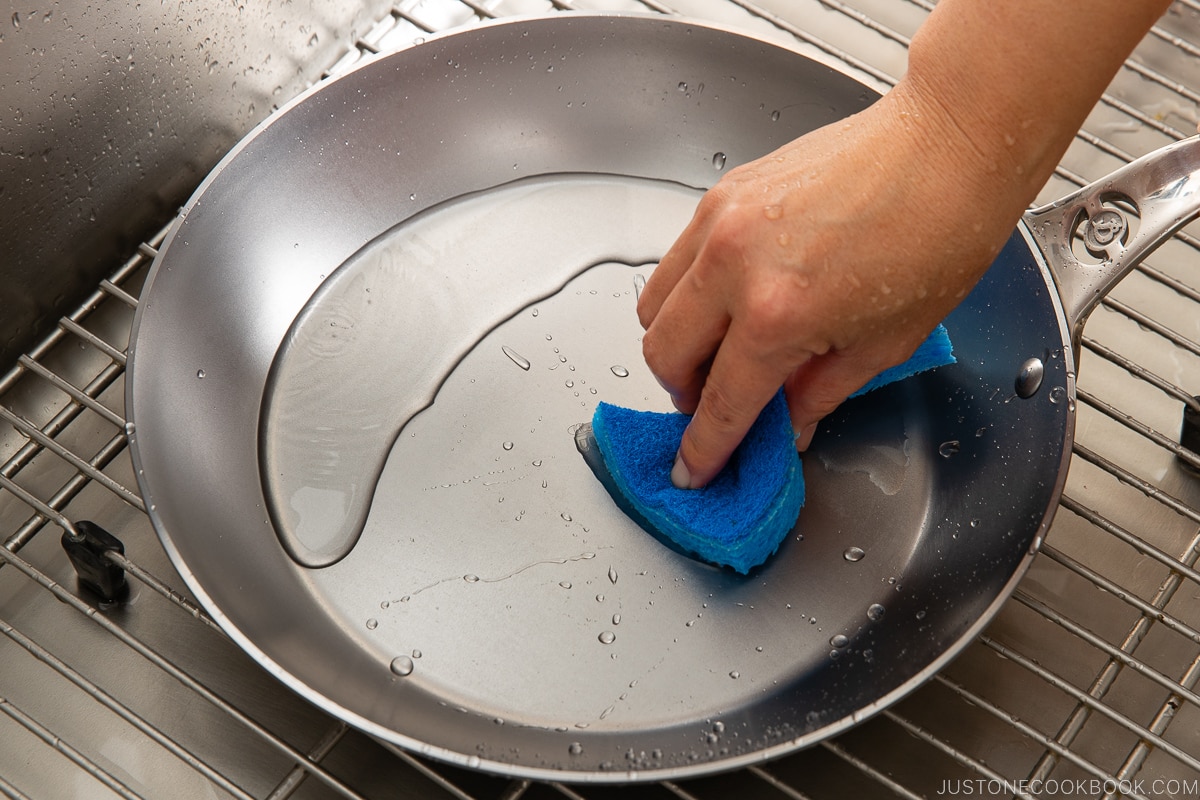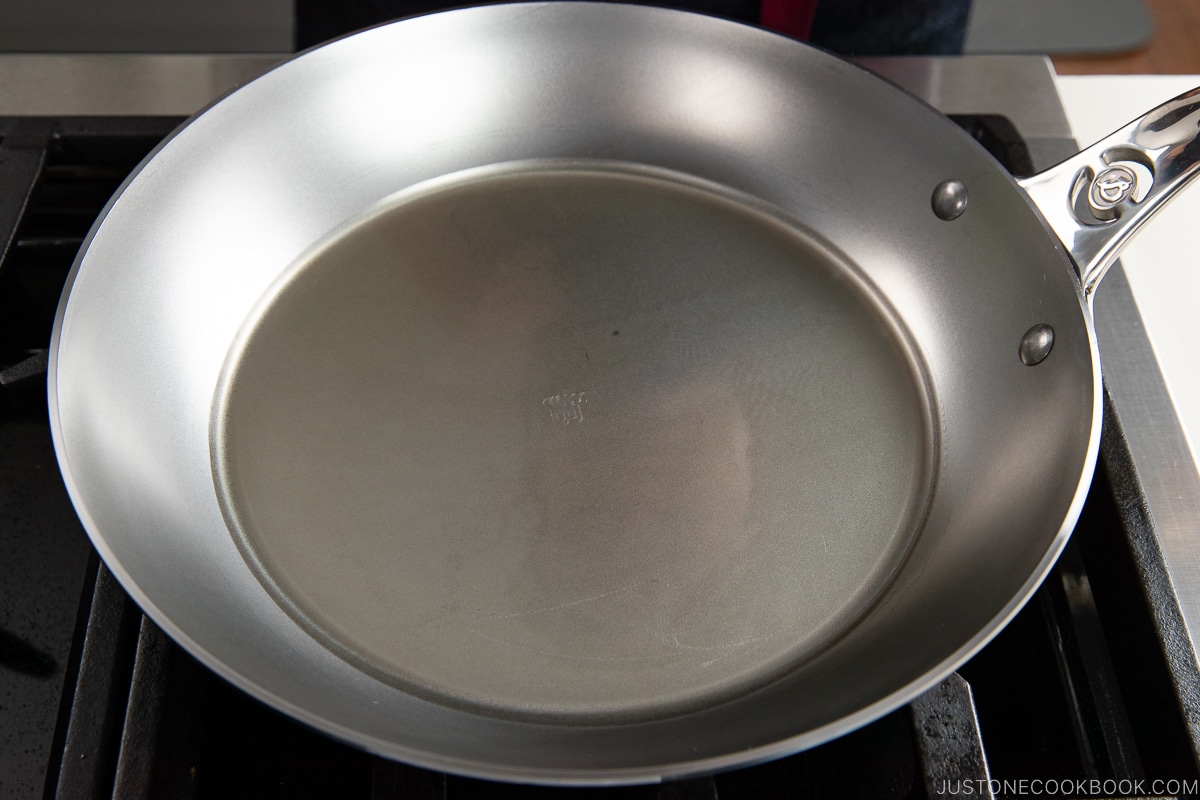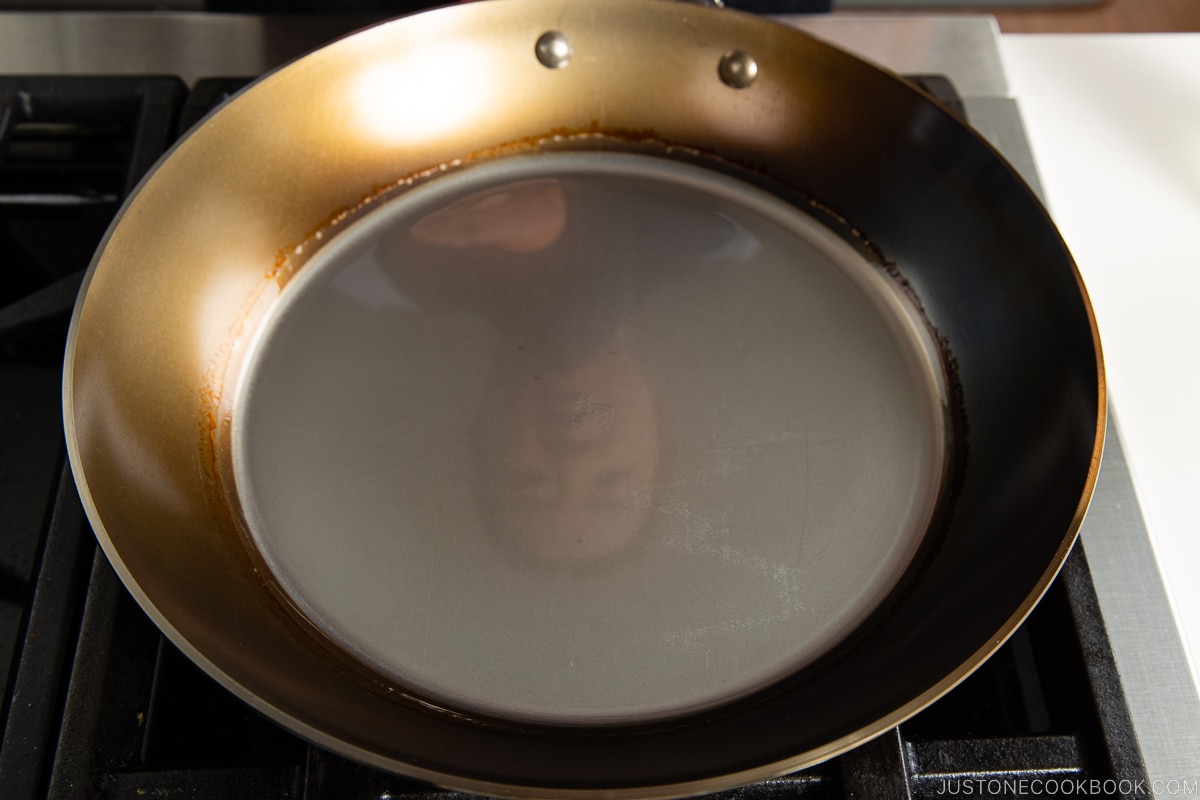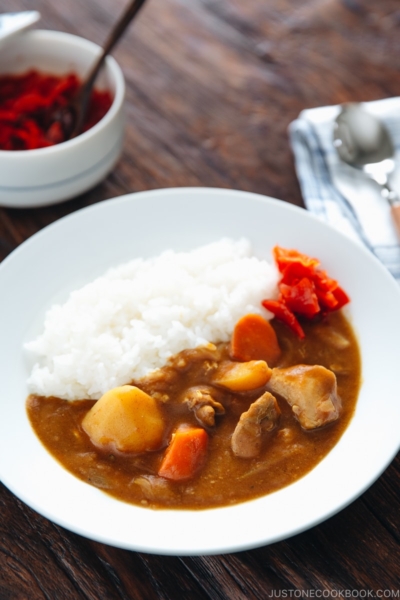We absolutely love our carbon steel pans. They are durable, easy to maintain, and do not contain toxic chemicals. Learn how to season a carbon steel pan with these simple steps.

Like most families, we were using non-stick frying pans for quite a long time. The main reasons are obvious. The convenience of cooking all types of food and the ease of cleaning. Whenever the protective coating started to peel or showed scratches, we would replace them. After a while, the cost seemed to be adding up as we were replacing them yearly the moment we spotted visible scores and scratches.
Why We Started Using Carbon Steel Pan
In 2018, we watched the investigative documentary called The Devil We Know. That was when we fully understood the toxic compounds that are used on non-stick cookware and the ill effects they have on the human body. It was a wake-up call and we started getting rid of all our non-stick cookware and switched to carbon steel pans.

What Is A Carbon Steel Pan
A carbon steel pan is simply a frying pan made with carbon and iron. The percentage of carbon may vary from various manufacturers but high-carbon steel is defined .6 to 1% carbon (the pans are typically 1% carbon). The pans are a bit heavier than stainless steel pans but still lighter than cast iron pans. Once seasoned, a natural nonstick layer forms on the pan and it’s really great for cooking almost all types of food and can handle high heat. Whereas non-stick pans shouldn’t be used at higher than medium heat.

What Are The differences Between Seasoned Carbon Steel And Seasoned Cast Iron?
Another popular type of pan that is without toxic non-stick coating is a cast-iron skillet. Cast iron cookware is also made of iron and carbon but with a higher carbon percentage. The key differences are that cast iron pans are heavier, don’t have a smooth surface for cooking, but do retain heat longer. However, they also take longer to heat up.

Seasoning And Cleaning
Now you know the similarities and differences between carbon steel vs. cast iron pans, let’s demystify the two most asked questions: how to season and clean these pans. Let’s cover the seasoning first.
Why Do We Need To Season A Carbon Steel Pan?
There are a few reasons why we need to season a carbon steel pan. First, seasoning creates a protective layer on the pan, preventing it from rusting. Second, seasoning also transforms the surface of the pan into a non-stick, enhancing the overall performance and durability of the pan. The very same reasons why we need to season a cast iron or a wok.
The seasoning process involves heating oil in the pan so that the fat bonds with the cooking surface and becomes part of the pan, forming a natural protective coating over time. This coating prevents your food from sticking just like the Teflon-type non-stick pans, only without the concerns of breaking down over high heat.
Luckily, seasoning a carbon steel pan is easy and straightforward. Once you season it properly, you can use the pan for frying eggs, searing a beautifully marbled steak, pan-frying tofu and gyoza, stir-frying vegetables, and more! It’s built to last and you’ll enjoy cooking with it.

We’ve tried a few different brands of carbon steel pans and we really like de Buyer’s. The main advantage is they are very easy to season compared to other brands we’ve had. de Buyer coats their pans in beeswax from the factory and it can be easily removed.
To season the de Buyer pan, simply scrub off the wax with hot water and a sponge. Pour a thin layer of oil and avoid getting it on the sides. Heat on medium-high until smoking and dispose of the oil. The pan is now ready to use.
Other brands of carbon steel pans require a bit more work to season. We’ve shared links to other seasoning methods at the bottom of this post. The methods include sautéing potato peels with salt multiple times and the oven method. We really don’t like the oven method as the kitchen becomes very smoky and the air becomes hard to breathe.
How To Season A Carbon Steel Pan
Step 1: Remove protective wax with a sponge and hot water


Depending on the manufacturer, various protective coating is applied. Regardless of the coating, it should be removed.
Step 2: Dry the pan thoroughly with a towel


Take extra time to dry the pan, any water leftover in the pan will splatter with hot oil causing potential harm and accidents.
Step 3: Pour 1 mm of oil to cover the bottom of the pan.


Do not pour more than 1 mm as the sides will burn the residual oil and turn the sides black instead of a beautiful patina finish.
Step 4: Heat the pan on medium-high




Once the stove is on, do not move the pan too much, and do not swirl the oil around. The oil residue will leave a black mark. Heat the oil until smoking, about 5-8 minutes depending on the stove. Once smoking, turn off the stove and let the oil cool.
Step 5: Pour the oil out and wipe down with a paper towel



Once the oil has cooled, pour it out and wipe the pan with a paper towel. It is now seasoned and ready to use! Easy right?
Maintenance And Making Your Pan Last
The more you use the pan, the darker it’ll become and the pan will take on a nice patina. It’ll become more and more non-stick with use. You can see in the gallery below with the newly seasoned pan, the fried egg already easily glides around.





The key is to remember to clean the pan only with hot water after each use. Here are the easy steps to maintaining your carbon steel pan.
How To Clean A Carbon Steel Pan
Step 1. Rinse with hot water and scrub with a brush/sponge


Do not use dish soap to wash your carbon steel pan. It’ll remove the natural non-stick coating. Any remaining food should come off easily with a brush or sponge.
Step 2. Heat the pan on the stove until dry and then pour a bit of oil


Heat the pan on medium heat until all the water has evaporated. Turn off the stove and pour a bit of oil into the pan.
Step 3. Rub oil all over the pan with a paper towel and let cool


If there are stubborn pieces of leftover food stuck onto the pan, I use these plastic scrapers to remove them. My favorite is the Lodge one since it’s very stiff and effective at removing food.

Additional Questions About Carbon Steel Pans
Q: What kind of cooktops work for carbon steel pans?
A: Carbon steel pans work on electric cooktops, induction cooktops, and gas burners. If you are using an induction cooktop to season the pan, bring the heat up slowly to prevent warping.
Q: What is the best oil to season a carbon steel pan?
A: For seasoning a carbon steel pan, it’s best to use a neutral oil with a high smoking point. Canola oil, vegetable oil, avocado oil, and sunflower oil are all great choices. Avoid butter and unrefined oils with lower smoking points.
Q: What do you use on the handles to protect from the heat?
A: The handles on some carbon steel pans heat up during cooking. We use a silicone pan grip to protect from the heat and provide a better grip.
Q: Any food to avoid on carbon steel pans?
A: Avoid cooking acidic food like tomato, citrus, and vinegar sauces. The acid in the food will remove the seasoning from the surface.
Q: Why does my pan still stick after seasoning?
A: It’s possible there are some food scraps on there or the seasoning has been scraped off from the surface. Just season it again with a thin layer of oil until smoking.
Q: Can you use metal utensils on carbon steel pans?
A: Yes, be gentle while the pan is still building the seasoning or you may see scratches. Once heavily seasoned, you don’t have to be concerned with metal utensils.
Q: How to re-season a carbon steel pan if it’s rusting?
A: Always rub down a pan after rinsing with oil to prevent rusting. de Buyer recommends using a rust cleaner to remove the rust. Scrub and re-season the pan.
Q: Are carbon steel pans oven safe?
A: Depending on the pan and the manufacturer. For example, de Buyer’s MINERAL B PRO is oven-safe but not MINERAL B.
Additional Resources For Seasoning Carbon Steel Pans
- How to season a carbon steel pan – oven method
- How to season a carbon steel pan – with potato peels and salt
- How to season a Matfer Bourgeat pan
Hope we answered any of the questions you may have about seasoning and maintaining carbon steel pans. Let us know in the comments below if you have any additional questions we did not cover.
JOC Discount Code
A special 10% discount code for JOC readers: JOCB10
You can use this code to shop at the de Buyer website. The discount code will apply to everything.
Carbon Steel Pans I Own
- 10¼-inch de Buyer MINERAL B Carbon Steel Crepe Pan
- 10¼-inch de Buyer MINERAL B Carbon Steel Frying Pan
- 11-inch de Buyer MINERAL B Carbon Steel Frying Pan
- 11-inch de Buyer MINERAL B PRO Carbon Steel Frying Pan *it’s only available on the de Buyer site.
- 11⅞-inch Matfer Bourgeat Black Carbon Steel Frying Pan








What is the difference between stainless steel and carbon steel?
The biggest difference between carbon steel and stainless steel pans comes down to how they perform and how much maintenance they need.
Carbon steel heats up faster and gives you great control. It’s perfect for searing, stir-frying, and once it’s well seasoned, even eggs can slide around on it as if it’s non-stick. But it does need a bit of caring: you’ll need to keep it dry, lightly oiled, and build up that seasoning over time to prevent rust. Once you get used to it, it becomes a routine and not much work at all. Actually, we prefer it since no soap is required for washing, rinse the bits off with really hot water and a scrubber.
Stainless steel, on the other hand, is lower maintenance and doesn’t rust, but it’s slower to heat and can be a little finicky with sticking unless you preheat and use enough oil. It’s great for browning, deglazing, and everyday cooking, and it can go in the dishwasher if needed (not recommended).
What kind of cookware would you use for acidic food like tomato, citrus, and vinegar sauces then?
Hi Rayna,
We use stainless steel pans (https://amzn.to/3GQ6akv), the All Clad ones are highly durable and should last 10 years or longer.
what kind of pan do
you use to make tomato and eggs? we make this dish often and the post says not to cook acidic food so wondering what you suggest
You can use any ceramic pans such as (https://amzn.to/48WnLB2), they are also toxic free.
Hi Nami,
I’ve been following your recipes for awhile and made a lot of them. My husband and I both love your recipes. I’m thinking to invest a de Buyer carbon stainless frying pan and would like to pair with a lid. However, I don’t see their site has a GLASS lid for the 11″ frying pan. In your yaki undon video, I see you used a glass lid when simmer the vegetables. May I know where the lid is from?
Hi Janet,
I think the lid is from an existing All-Clad or Calphalon pan that Nami uses with the de Buyer frying pans. However, due to the unique design of the de Buyer handle, it’s not a perfect fit, and there are some slight gaps. If you don’t have a suitable lid at home, we recommend trying a few glass lids from Amazon to find the best match.
Hope this helps!
Would you be able to comment on what recommended rice cookers have non-stick coatings, and which do not? Thank you.
Hi Margret! I’ve been using a donabe to cook rice everyday so that I can avoid using a non-stick coating as much as possible except for certain time that I require cooking rice overnight (when I don’t have frozen rice for kids’ lunch box…). I love my zojirushi rice cooker so I don’t plan to look for another rice cooker at this time. I just use less since I am usually in the kitchen when I cook rice on the stovetop while cooking a main dish.
One more thing: de Buyer is a very good, highly regarded company. Their customers are mainly professional cooks and chefs. I have a variety of different pots, pans and utensils. All their products are excellent, made to last and perform.
Kudos, Mr. JOC. You are spot on. I came to the same conclusion and my choice was also the de Buyer. The pans are great and the 10 inch pan is in daily use and just remains on the stove top…never missing the non-stick pans; food taste so much better in the carbon steel pans as well.
We all should do what we can to get (all, there are thousands of different formula out,) these man-made chemicals out of our lives. We are late anyway, in over 99% of all life, humans, animals and plants, these non-destructable chemicals can be found. It’s a scandal, the companies knew about the involved health problems and still continued to poison this world.
For the past five years I have owned four carbon steel pans. Every one of them rusted despite following carefully the instructions on how to maintain the pan. Each pan costed me close to $100. I finally gave up on using carbon steel pans and bought myself a decent stainless steel pan from a Chinese market, only $18. After seasoning the pan, I have been using it for the last 8 months without any problems. I am very happy with this cheap Chinese stainless steel pan.
Why does the boiled water on my carbon steel pan turn brown? Is it rust coming from the pan? Can i still use it? What is the best brand of rust remover?
Thank you for your great article on carbon steel pan. May i ask after cleaning the carbon steel pan, i have to give it a layer or oil coating for storing.
Do i have to give it a rinse with water and brush the pan, when i want to use it again ? I find it weird to cook with the pan with a layer or oil coating from the day before.
Can i wash with room temp water instead of warm/hot water ?
Hi Benzzo,
Essentially everything you would do for the proper care and feeding of carbon steel is the same as cast iron.
If cast iron is “too rough”… I took a 220 grit orbital sander to mine and now they are beautiful.
de Buyer makes good pans! I have a stainless pan. Incidentally, Green Pan makes a good non PFOA and PFAS frying pans. Have you tried them (Valencia Pro, below link)?
(https://www.greenpan.us/collections/frypans/products/valencia-pro-ceramic-non-stick-2-piece-open-frypan-set-10-and-12-inch#
Hi Dan, We’ve never tried ceramic pans since it’s not metal utensil friendly and more sensitive to high heat.